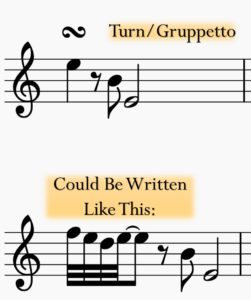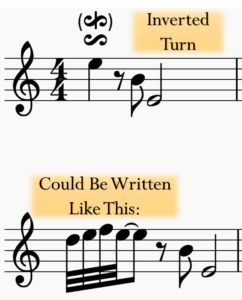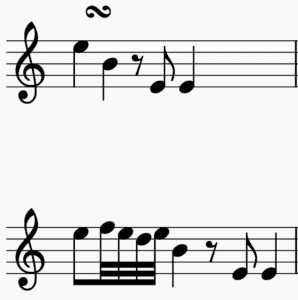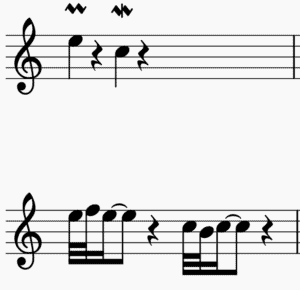This post contains affiliate links. We earn commissions if you purchase products from retailers after clicking on a link from our site. As an Amazon Associate, we earn from qualifying purchases.
It’s amazing what kind of musical notation you can stumble on. You might have seen an S or a squiggly line that’s not a trill above your music, and thought “how on earth do I play that?” Well, hopefully by the end of this article you’ll know how.
What is that Sideways S in Music? The turn, also known as the gruppetto, appears as a sideways S above the staff. The “turn”, based on its orientation signifies playing the the note above or below the “primary” note, the primary note itself, the note above or below the turn note, and then the primary note itself again. Mordents are played similarly without the last note.
I admit, as I was doing research for this article, I found some good information on Wikipedia. But, if you’re like me, you found the information a little lacking–so I decided to write a bit more in depth with some examples.
First I’ll explain the sideways S, or the Gruppetto, and then I’ll talk about Mordents… because they also kind of look like S’s, and I think it will help the discussion since the concept is similar.
If you didn’t find what you are looking for, I explain all the S-shaped music symbols in my other post here.
How to Play a Turn, aka Gruppetto
A turn, also known as a gruppetto shows up as a sideways S above the staff. Such as is shown here:

By the way, looking for recording equipment and musical instruments? Check out Sweetwater.com for microphones, monitors, audio interface or any other recording gear that you could ever need. (Affiliate Link)
A turn is a kind of shorthand used to tell the musician to quickly play a set of notes. The turn is usually placed above (but can be placed between two notes) a note, which I will call the primary notes. A turn signals the musician to play 4 notes in this order for a normal turn.
- The note above the primary note
- The primary note
- The note below the primary note
- The primary note, again
The shape of the gruppetto actually gives a clue to how the note should be played. If you look at this picture, you can imagine the gruppetto as a kind of slide with a dip where you start above the primary note, dip below, and then return back again.

The speed that you play a turn is usually fast, like you would a trill, but it’s completely up to the piece and the music director.
This is an example of a turn within a song, and how it would look if all the notes were drawn out.

Whether you initiate the turn at the beginning or end of the note is again up to the interpretation of the music director.
Inverted Gruppetto
A turn can also be inverted–the notation for this can appear in two different ways, such as you can see here:

The inverted turn appears as a sideways S with the main ramp of the S going up. The inverted turn can also appear as the same symbol but with a vertical line going up the middle.
An inverted turn is played in the inverse, in the following order
- The note below the primary note
- The primary note
- The note above the primary note
- The primary note, again
Using the same visualization, you can imagine the inverted gruppetto as a ramp wherein you start below the primary note, pass it, and then go back down again.

An example of what the inverted turn would look like if you wrote out all the notes:

Turn Between Two Notes (offset gruppetto)
Perhaps the most interesting variation and use of a gruppetto is when the gruppetto is placed between two notes. When a gruppetto is placed between two notes, this impacts whether you perform the turn at the beginning or at the end of the note, such as you can see in the example below:

As you can see from the example, since the turn is placed between the two notes, you hold out the first note before performing the turn.
The interesting part about this particular ornament is that the interpretation of the turn’s rhythm may vary from song to song. It mostly depends on the style of the piece and the interpretation of the music director. Try listening to recordings of the song to get an idea of how others have interpreted the rhythm.
Examples of a Turn in Music
So, apparently the turn was the cool thing to do in baroque music. I wanted to see for myself some examples and did a bit of digging for y’all so you can see a real example
Bach Goldberg Variations has an example here:

Although I didn’t find this specific notation in the several pieces I looked at, what I did see was a TON of examples of mordents.
How to Play a Mordent
A mordent is similar in concept to a turn, except rather than starting above or below the primary note, you start on the primary note, and alternate as you would a turn, beginning with the primary note, then the note above, and then the primary note again. You can think of a mordent as a mini trill.
This may be the reason why you came here. The mordent kind of looks like a sideways S, so I wanted to include this information so you could find what you need.

The above is an example of an upper mordent, and an lower mordent. Rather than worrying about the orientation of the squiggly line (that’s the scientific term, mind you), the lower mordent just looks like a regular mordent with a vertical line down the middle. Nice and simple.
I am kind of surprised that I couldn’t find conclusive names for mordent ornamentation. In one place a mordent may be referred to as an inverted mordent. Thankfully, the interpretation seems to be consistent of the actual marking in music as far as which notes to play.
